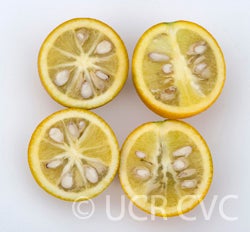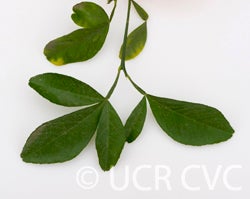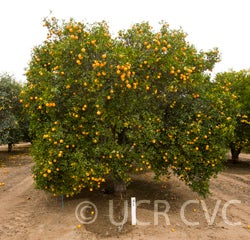X Citroncirus sp. RUTACEAE
Citrus sinensis 'Washington' sweet orange X Poncirus trifoliata
CRC 1459
PI 539810
VI 86
Source
Received as budwood from W.T. Swingle, USDA, 1924.
Parentage/origin
Citrus sinensis 'Washington' x Poncirus trifoliata. Open pollinated seedling.
Rootstocks of accession
Carrizo citrange, C-35 citrange
Season of ripeness at Riverside
December to January
Notes and observations
HJ Webber: When I visited the tree of this in Field 8A with Swingle on 12/04/34, he was much pleased with its vigor and numerous plump seeds and told me to put down the name Troyer for it as the first fruits came to him from a Mr. Troyer at Fairhope, Alabama. It thus becomes the Troyer citrange and I will describe it under that name in my Variety manuscript.
Description from The Citrus Industry Vol. 1 (1967)
"Fruit small, oblate to spherical; smooth and nearly glabrous; color light orange. Rind medium-thick, with numerous oil glands; tightly adherent. Segments 9 to 10 and axis solid. Flesh color light yellow; juicy; flavor strongly acid and bitter. Seeds numerous, plump, and highly polyembryonic. Season of maturity early.
Tree vigorous, upright-spreading, and medium-large with rather slender, thorny branchlets; foliage moderately dense, evergreen to semi-evergreen. Leaves dark green, medium in size, and mainly trifoliolate, occasionally unifoliolate. Productive and hardy.
This variety originated as a hybrid of the Washington navel orange crossed with trifoliate orange pollen (hence is actually a citruvel) that was made by E. M. Savage, under the direction of W. T. Swingle of the U.S. Department of Agriculture, at Riverside, California, in 1909. In 1934, Swingle named it for A. M. Troyer, on whose place at Fairhope, Alabama, it was first fruited. The rise of this rootstock to prominence in California has been spectacular. Within less than twenty-five years from the first field trial it has become the rootstock most employed and is much in demand elsewhere."
Availability
Commercially available in California through the Citrus Clonal Protection Program. Click here to order budwood.
USDA Germplasm Resources Information Network page for Troyer citrange
Bibliography
E. M. Savage and F. E. Gardner. "THE ORIGIN AND HISTORY OF TROYER AND CARRIZO CITRANGES". The Citrus Industry. February 1965.



